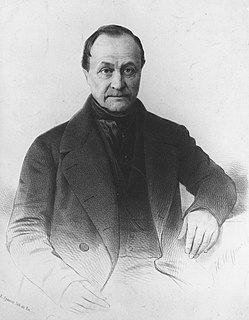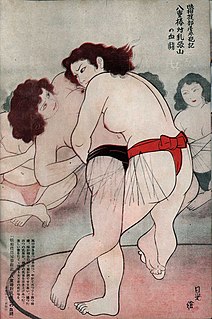Related Research Articles
Behavior or behaviour is the actions and mannerisms made by individuals, organisms, systems or artificial entities in conjunction with themselves or their environment, which includes the other systems or organisms around as well as the (inanimate) physical environment. It is the computed response of the system or organism to various stimuli or inputs, whether internal or external, conscious or subconscious, overt or covert, and voluntary or involuntary.
A lens is a transmissive optical device that focuses or disperses a light beam by means of refraction. A simple lens consists of a single piece of transparent material, while a compound lens consists of several simple lenses (elements), usually arranged along a common axis. Lenses are made from materials such as glass or plastic, and are ground and polished or molded to a desired shape. A lens can focus light to form an image, unlike a prism, which refracts light without focusing. Devices that similarly focus or disperse waves and radiation other than visible light are also called lenses, such as microwave lenses, electron lenses, acoustic lenses, or explosive lenses.

Lithography is a method of printing originally based on the immiscibility of oil and water. The printing is from a stone or a metal plate with a smooth surface. It was invented in 1796 by German author and actor Alois Senefelder as a cheap method of publishing theatrical works. Lithography can be used to print text or artwork onto paper or other suitable material.

Pride is positive emotional response or attitude to something with an intimate connection to oneself, due to its perceived value. Oxford defines it amongst other things as "the quality of having an excessively high opinion of oneself or one's own importance" This may be related to one's own abilities or achievements, positive characteristics of friends or family, or one's country. Richard Taylor defined pride as "the justified love of oneself", as opposed to false pride or narcissism. Similarly, St. Augustine defined it as "the love of one's own excellence", and Meher Baba called it "the specific feeling through which egoism manifests."

Isidore Marie Auguste François Xavier Comte was a French philosopher and writer who formulated the doctrine of positivism. He is often regarded as the first philosopher of science in the modern sense of the term. Comte's ideas were also fundamental to the development of sociology; indeed, he invented the term and treated that discipline as the crowning achievement of the sciences.

Positive feedback is a process that occurs in a feedback loop which exacerbates the effects of a small disturbance. That is, the effects of a perturbation on a system include an increase in the magnitude of the perturbation. That is, A produces more of B which in turn produces more of A. In contrast, a system in which the results of a change act to reduce or counteract it has negative feedback. Both concepts play an important role in science and engineering, including biology, chemistry, and cybernetics.
Appreciative inquiry (AI) is a model that seeks to engage stakeholders in self-determined change. According to Gervase Bushe, professor of leadership and organization development at the Beedie School of Business and a researcher on the topic, "AI revolutionized the field of organization development and was a precursor to the rise of positive organization studies and the strengths based movement in American management." It was developed at Case Western Reserve University's department of organizational behavior, starting with a 1987 article by David Cooperrider and Suresh Srivastva. They felt that the overuse of "problem solving" hampered any kind of social improvement, and what was needed were new methods of inquiry that would help generate new ideas and models for how to organize.
Body image is a person's thoughts, feelings and perception of the aesthetics or sexual attractiveness of their own body. The concept of body image is used in a number of disciplines, including neuroscience, psychology, medicine, psychiatry, psychoanalysis, philosophy, cultural and feminist studies; the media also often uses the term. Across these disciplines, there is no single consensus definition, but broadly speaking body image consists of the ways people view themselves; their memories, experiences, assumptions, and comparisons about their own appearances; and their overall attitudes towards their own respective heights, shapes, and weights—all of which are shaped by prevalent social and cultural ideals.

The longitude of the ascending node is one of the orbital elements used to specify the orbit of an object in space. It is the angle from a specified reference direction, called the origin of longitude, to the direction of the ascending node, as measured in a specified reference plane. The ascending node is the point where the orbit of the object passes through the plane of reference, as seen in the adjacent image. Commonly used reference planes and origins of longitude include:
Reputation management refers to the influencing and controlling or concealing of an individual's or group's reputation. Originally a public relations term, the growth of the internet and social media, led to growth of reputation management companies, made search results can make core part of an individual's or group's reputation. Online reputation management, sometimes abbreviated as ORM, focuses on the management of product and service search website results. Ethical grey areas include mug shot removal sites, astroturfing customer review sites, censoring negative complaints, and using search engine optimization tactics to influence results. In other cases, the ethical lines are clear; some reputation management companies are closely connected to websites that publish unverified and libelous statements about people. The reputation management companies charge thousands of dollars to remove these posts – temporarily – from their websites.

User-generated content (UGC), alternatively known as user-created content (UCC), is any form of content, such as images, videos, text, and audio, that has been posted by users on online platforms such as social media and wikis. It is a product consumers create to disseminate information about online products or the firms that market them.
System justification theory (SJT) is a theory within social psychology that system-justifying beliefs serve a psychologically palliative function. It proposes that people have several underlying needs, which vary from individual to individual, that can be satisfied by the defense and justification of the status quo, even when the system may be disadvantageous to certain people. People have epistemic, existential, and relational needs that are met by and manifest as ideological support for the prevailing structure of social, economic, and political norms. Need for order and stability, and thus resistance to change or alternatives, for example, can be a motivator for individuals to see the status quo as good, legitimate, and even desirable.

Social media are interactive technologies that allow the creation or sharing/exchange of information, ideas, career interests, and other forms of expression via virtual communities and networks. While challenges to the definition of social media arise due to the broad variety of stand-alone and built-in social-media services currently available, there are some common features:
- Social media are interactive Web 2.0 Internet-based applications.
- User-generated content—such as text posts or comments, digital photos or videos, and data generated through all online interactions—is the lifeblood of social media.
- Users create service-specific profiles for the website or app that are designed and maintained by the social-media organization.
- Social media helps the development of online social networks by connecting a user's profile with those of other individuals or groups.

Fat feminism, often associated with "body-positivity", is a social movement that incorporates feminist themes of equality, social justice, and cultural analysis based on the weight of a woman or a non-binary feminine person. This branch of feminism intersects misogyny and sexism with anti-fat bias. Fat feminists advocate body-positive acceptance for all bodies, regardless of their weight, as well as eliminating biases experienced directly or indirectly by fat people. Fat feminists originated during third-wave feminism and is aligned with the fat acceptance movement. A significant portion of body positivity in the third-wave focused on embracing and reclaiming femininity, such as wearing makeup and high heels, even though the second-wave fought against these things. Contemporary western fat feminism works to dismantle oppressive power structures which disproportionately affect fat, queer, non-white, disabled, and other non-hegemonic bodies. It covers a wide range of topics such as diet culture, fat-phobia, representation in media, ableism, and employment discrimination.

The Swiss Inventory of Cultural Property of National and Regional Significance is a register of cultural property in Switzerland. It was established according to article 5 of the second protocol to the Hague Convention for the Protection of Cultural Property in the Event of Armed Conflict, which provides for the establishment of national registers of cultural property.
The Palomar Transient Factory, was an astronomical survey using a wide-field survey camera designed to search for optical transient and variable sources such as variable stars, supernovae, asteroids and comets. The project completed commissioning in summer 2009, and continued until December 2012. It has since been succeeded by the Intermediate Palomar Transient Factory (iPTF), which itself transitioned to the Zwicky Transient Facility in 2017/18. All three surveys are registered at the MPC under the same observatory code for their astrometric observations.
In social psychology, collective narcissism is the tendency to exaggerate the positive image and importance of a group to which one belongs. The group may be defined by religion, social class, race, political stance, language, nationality, employment status, education level, cultural values, or any other ingroup. While the classic definition of narcissism focuses on the individual, collective narcissism extends this concept to similar excessively high opinions of a person's social group, and suggests that a group can function as a narcissistic entity.
Peace psychology is a subfield of psychology and peace research that deals with the psychological aspects of peace, conflict, violence, and war. Peace psychology can be characterized by four interconnected pillars: (1) research, (2) education, (3) practice, and (4) advocacy. The first pillar, research, is documented most extensively in this article.

Body positivity is a movement focused on the acceptance of all bodies, regardless of size, shape, skin tone, gender, and physical abilities, while challenging present-day beauty standards as an undesirable social construct. Proponents focus on the appreciation of the functionality and health of the body, instead of its appearance.

The COVID-19 pandemic was first confirmed in the Indian state of West Bengal on 17 March 2020 in Kolkata. The Health and Family Welfare department of Government of West Bengal has confirmed a total of 13,43,442 COVID-19 positive cases, including 1,09,806 active cases, 15,120 deaths and 12,18,516 recoveries, as of 28 May 2021.
References
- ↑ Cooperrider. "Positive image, positive action: The affirmative basis of organizing" (PDF). Archived from the original (PDF) on 29 December 2009. Retrieved 14 March 2010.